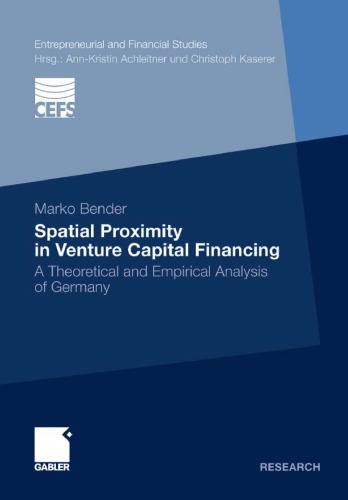

Most ebook files are in PDF format, so you can easily read them using various software such as Foxit Reader or directly on the Google Chrome browser.
Some ebook files are released by publishers in other formats such as .awz, .mobi, .epub, .fb2, etc. You may need to install specific software to read these formats on mobile/PC, such as Calibre.
Please read the tutorial at this link: https://ebookbell.com/faq
We offer FREE conversion to the popular formats you request; however, this may take some time. Therefore, right after payment, please email us, and we will try to provide the service as quickly as possible.
For some exceptional file formats or broken links (if any), please refrain from opening any disputes. Instead, email us first, and we will try to assist within a maximum of 6 hours.
EbookBell Team

0.0
0 reviews
ISBN 13: 9783834926845
Author: Marko Bender
Marko Bender analyzes the impact of spatial proximity between venture capitalists and new ventures throughout the investment process. He elaborates a comprehensive theoretical framework and empirically validates resulting hypotheses concerning the observed spatial proximity and the impact of spatial proximity on the likelihood of a venture capital investment using a German dataset.
1 Introduction
1.1 Problem and Aims of Analysis
1.2 Research Methodology
1.3 Outline of the Thesis
2 Fundamentals of Venture Capital Financing and Spatial Proximity
2.1 Venture Capital Financing 2.1.1 Definition of Venture Capital
2.1.2 Characteristics of Portfolio Companies
2.1.3 Characteristics of German Venture Capitalist Types
2.1.3.1 Private Venture Capitalists
2.1.3.2 (Quasi-)public Venture Capitalists
2.1.4 Venture Capital Investment Process
2.1.4.1 Deal Origination
2.1.4.2 Deal Screening
2.1.4.3 Deal Due Diligence
2.1.4.4 Deal Structuring
2.1.4.5 Investment Development
2.1.4.6 Investment Exit
2.2 Spatial Proximity 2.2.1 Definition of Spatial Proximity
2.2.2 Spatial Distribution of Venture Capitalists and Venture Capital Investments
2.2.3 First Implications Regarding the Role of Spatial Proximity in Venture Capital Financing
2.3 Overview of Relevant Literature
general studies
observed patterns in spatial prox-imity between venture capitalists and portfolio companies.
impact of spatial proximity on the likelihood of a VC investment.
impact of spatial prox-imity on specific aspects of VC transactions.
3 Relevant Theories for the Analysis of Spatial Proximity in Venture Capital Financing
3.1 Identification of Relevant Theories
3.2 Theories Relevant to the Venture Capitalist Entrepreneur Dyad 3.2.1 New Institutional Economics
3.2.1 New Institutional Economics as Starting Point
3.2.1.1 Property Rights Theory
3.2.1.2 Agency Theory
3.2.1.3 Transaction Cost Theory
3.2.2 Further Theories Explaining the Role of Spatial Proximity
3.2.2.1 Game Theory
3.2.2.2 Stewardship Theory
3.2.2.3 Social Exchange Theory
3.3 Theories Relevant beyond the Venture Capitalist Entrepreneur Dyad: Network Approach
3.3.1 Theoretical Foundations
3.3.1.1 Approach of Inter-Organizational Networks
3.3.1.2 Formal Network Analysis
3.3.2 Relevant Networks
3.3.3 Implications of Spatial Proximity between Actors
3.4 Summary
4 Impact of Spatial Proximity throughout the Venture Capital Investment Process
4.1 Pre-Contractual Activities
4.1.1 Deal Origination
4.1.2 Deal Screening
4.1.3 Deal Due Diligence
4.1.4 Deal Structuring
4.2 Post-Contractual Activities
4.2.1 Investment Development
4.2.1.1 Monitoring
4.2.1.2 Support
4.2.2 Investment Exit
4.3 Summary and Testable Hypotheses
4.3.1 General Impact of Distance
4.3.2 New Venture Characteristics
4.3.3 Venture Capitalist Characteristics
4.3.4 Investment Round Characteristics
5 Empirical Analysis of Relationships between Spatial Proximity and the Type and Likelihood of Ventu
5.1 Description of Dataset
5.1.1 Available Datasets for Analysis
5.1.2 Used Dataset
5.1.3 Measurement and Definition of Variables
5.1.3.1 Spatial Proximity
5.1.3.2 New Venture Characteristics
5.1.3.3 Venture Capitalist Characteristics
5.1.3.4 Investment Round Characteristics
5.1.3.5 Control Variables
5.1.4 Summary Statistics
5.1.5 Possible Selection Biases
5.2 Patterns in Spatial Proximity between Venture Capitalists and Investees
5.2.1 Empirical Strategy to Investigate Patterns in Spatial Proximity
5.2.2 First Bivariate Analyses
5.2.3 Ordered Logistic Regressions
5.2.4 Robustness Tests of Conducted Analyses
5.2.5 Limitations of Analyses
5.3 Impact of Spatial Proximity on the Likelihood of a Venture Capital Investment
5.3.1 Empirical Strategy to Investigate the Likelihood of a Venture Capital Investment
5.3.2 Rare Event Logistic Regressions
5.3.3 Robustness Tests of Conducted Analyses
5.3.4 Limitations of Analyses
5.4 Summary of Results and Discussion
6 Conclusion
6.1 Summary of Results
6.2 Implications of the Impact of Spatial Proximity on Venture Capital Financing 6.2.1 Implications
6.2.2 Policy Implications
6.2.3 Implications for Venture Capitalists
6.3 Further Research and Outlook
spatial proximity in venture capital financing
5 capital management
spatial vc
k2 venture partners
k2 capital ventures
Tags: Marko Bender, Spatial, Proximity